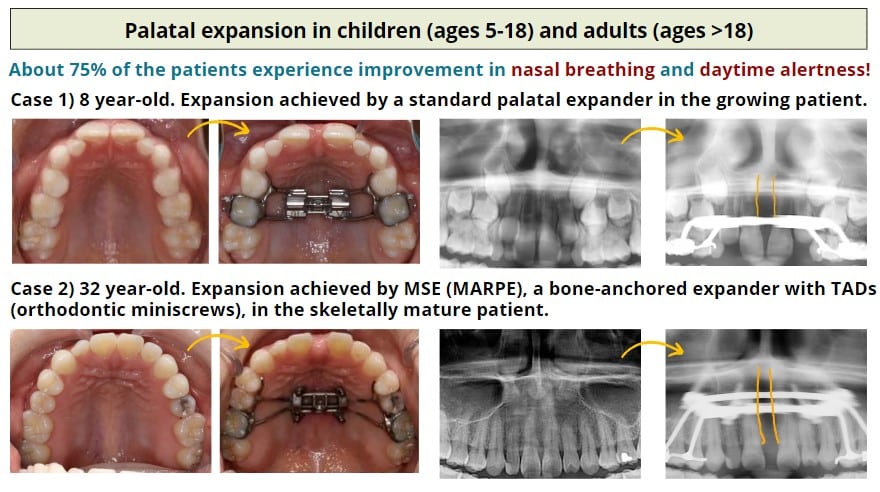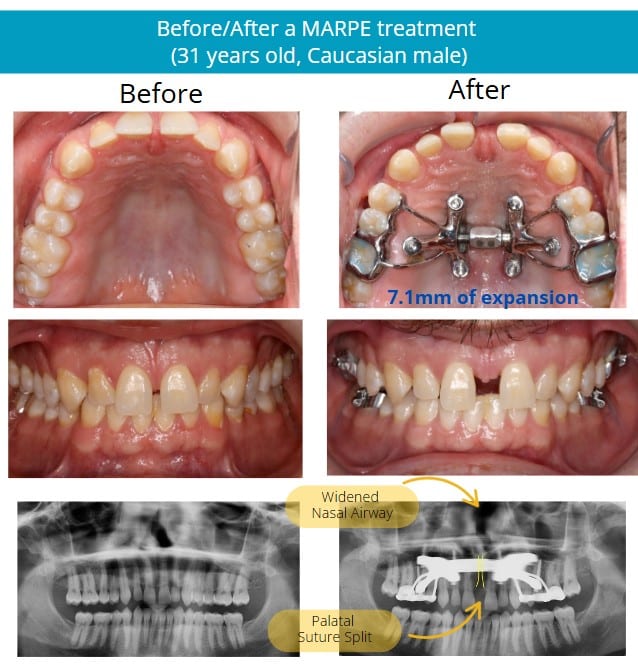What is Airway Orthodontics?
At Clearwave Orthodontics is a lot more than just straight teeth and a beautiful smile. We are focused on the overall health of our patients. One specific area this philosophy becomes important is when one has a crowded or crooked smile. This is a sign that the jaw is not growing properly. Certain oral habits and jaw deformities can lead to Obstructive Sleep Apnea (OSA). Airway Orthodontics refers to orthodontic treatment methods used to expand a patient’s airway in order to treat OSA. What is Obstructive Sleep Apnea (OSA)?
Obstructive Sleep Apnea occurs when the airway closes sufficiently during sleep and breathing stops. This triggers release of cortisol (the “fight or flight” or “survival” stress hormone) that increases heart rate and activates muscles to force breathing. Although the person doesn’t actually wake, they are driven from deep restorative sleep to “catch their breath”. Once they begin to relax to the deeper levels of sleep, it happens all over again.
This is hard on the body, imagine running a race all night long. You wake up exhausted and unrested, but more importantly, prolonged levels of increased cortisol negatively affects the immune system, normal hormone production, insulin function, gastric acid production, learning and memory retrieval, and a host of other organs and body functions.
Symptoms of OSA
- Snoring
- Mouth Breathing
- Enlarged Tonsils/Adenoids
- Facial & Jaw Deformities
- Restless Sleep & Drowsiness During the Day
- Moodiness
- Short Attention Span or ADD/ADHD
- Bed Wetting
Causes
The most common and significant causes of OSA are:
- Obstructive tissues (enlarged tonsils, adenoids, turbinate bones (in the nose), deviated septum)
- Lack of room for the tongue (narrow palate, tongue-tied, lingually tipped teeth)
- Recessive upper and lower jaws
Treatment
We treat OSA in accordance with the American Association of Orthodontics, the American Academy of Otolaryngology and the American Academy of Pediatrics. The treatment of OSA involves below methods:
- Growth-oriented Orthodontics (jaw expansion, advancement of upper and/or lower jaws to create room for the tongue and open the airway) rather than pulling teeth.


- Collaboration with local ENTs (Ear-Nose-Throat specialists, also known as Otolaryngologists) to properly evaluate and reduce obstructive tissues (allergy correction, remove Tonsils/Adenoids, etc).
- Research has shown that the best results occur when both Orthodontics and ENT treatments are done! Orthodontics addresses the hard-tissue problems (jaw bones and teeth), while ENT addresses the soft-tissue problems.
- Collaboration with local Pulmonologists to provide Sleep Apnea Devices (dental appliance) for patients who cannot tolerate CPAP or declined CPAP treatment. The device is billable to either medical or dental insurance, depending on your individual plan.
- In adults with narrow palate, we expand the palate and the nasal airway using miniscrew-assisted rapid palatal expander (MARPE), distraction osteogenesis for maxillary expansion (DOME), or surgery-assisted rapid palatal expander (SARPE). We are one of the three major MARPE providers in the Southern California. For MARPE, we perform Piezo corticotomy on the palatal suture in our office, under local anesthesia, to aid the opening of the palatal suture in adults. You can go about your day immediately after the MARPE installation. MARPE is always followed by a full orthodontic treatment, and the temporary gap that develops between the top front teeth will be closed quickly. With 10+ years of experience and having done more than 300 MARPE cases at 98% success rate, Dr. Jinny will make the MARPE journey as smooth and comfortable as possible.
- In adults with severe jaw misalignment, jaw surgery may be more ideal. Jaw surgeries require a collaboration between an Orthodontist and an Oral Maxillofacial Surgeon (OMFS). Jaw surgery for sleep apnea specially is a lot of times covered by medical insurances, which we will walk through the process with you at your consultation visit.
When to Assess and Treat?
As soon as you are aware of the problem! Although 7-8 years of age is an important age for orthodontic correction, we can make a big difference in 3- to 6-year-olds with some simple and timely care. For adults looking for MARPE treatment or surgical jaw alignment (orthognathic surgery) to address breathing issues, there is basically no age limit as long as they are otherwise healthy. Contact our office today for a free consultation.







